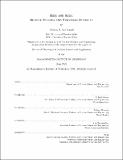Hide and Seek: Remote Sensing and Strategic Stability
Author(s)
MacDonald, Thomas D.
DownloadThesis PDF (6.039Mb)
Advisor
Kemp, R. Scott
Hartwig, Zachary
Danagoulian, Areg
Terms of use
Metadata
Show full item recordAbstract
The competition between the survivability of nuclear arsenals and the counterforce weapons that hold them at risk has been ongoing since the dawn of the nuclear age. A spate of technological and political developments have called the endurance of stability into question once again. This thesis addresses one particular aspect of the competition between technologies of counterforce and strategies of survivability, the use of space-based radar systems to track ground-based mobile missiles carried by TELs (transporter-erector-launcher vehicles).
The work herein describes the development of a set of interlocking models to determine under what conditions space-based radar systems can be used to track TELs, the costs of doing so, and the vulnerability of those systems to countermeasures. This work contributes to an ongoing debate in the security studies literature on the impact of changing technology on strategic stability. I offer policy recommendations on future deployments of SBR systems, evaluate the capabilities of current remote-sensing systems, and provide a framework for evaluating emerging technologies.
In developing these models, the capabilities of radar modalities are reviewed, the tasks that are required to track moving targets are identified, and a scheme for SBR tracking of TELs is developed. A set of satellite constellations are designed and simulated, and their ability to detect TELs is determined by Monte Carlo simulation. A model of the seeker's uncertainty is developed, and geometric tiling is used to model attack planning. Drawing on real-world nuclear forces, model counterforce attacks against a peer and sub-peer adversary are used to determine the number of satellites needed to enable tracking.
SBR systems which are capable of tracking TELs are found to require 50 or more satellites, depending on the conditions, with a total system price tag on the order of a few hundred billion dollars. Countermeasures to SBR tracking are identified and evaluated. SBR systems are found to be vulnerable to a number of countermeasures which are low cost or already at hand, making it unlikely that current or future deployments of SBR systems will meaningfully disrupt strategic stability by undermining the survivability of ground-based mobile missiles.
Date issued
2021-06Department
Massachusetts Institute of Technology. Department of Nuclear Science and EngineeringPublisher
Massachusetts Institute of Technology